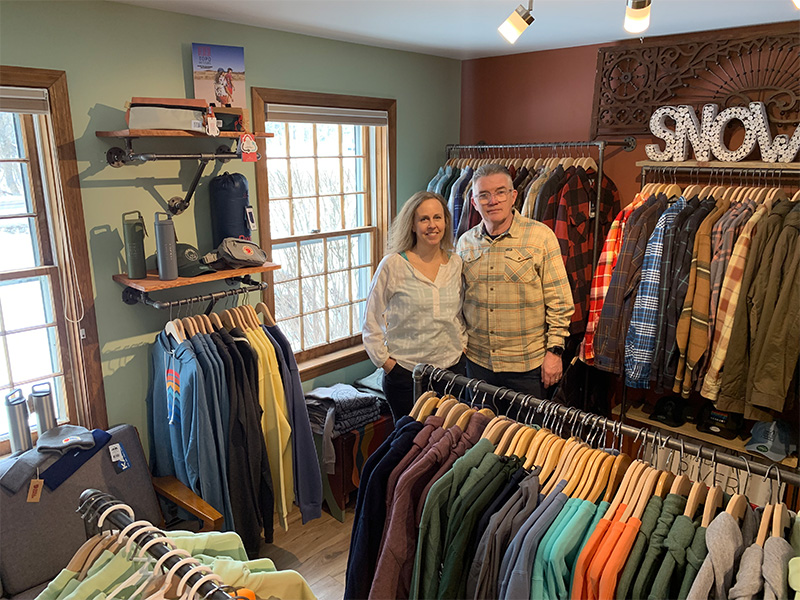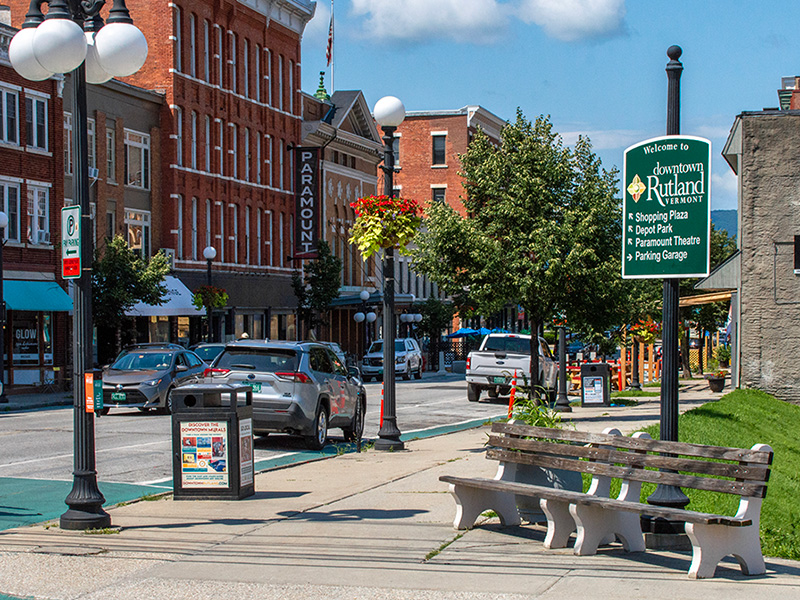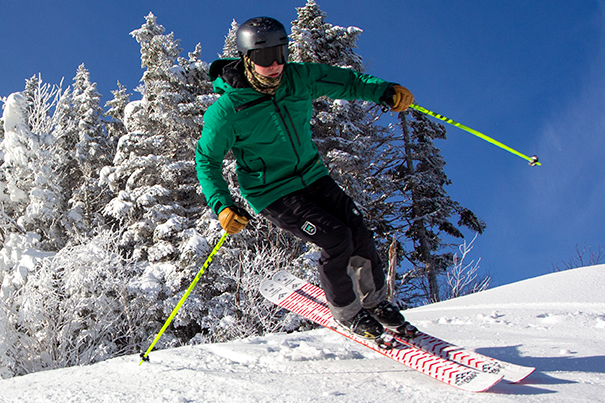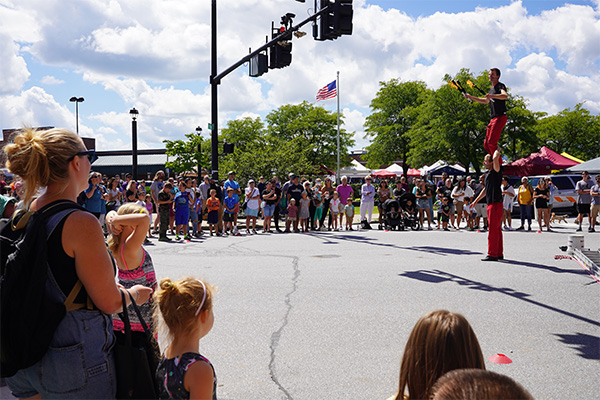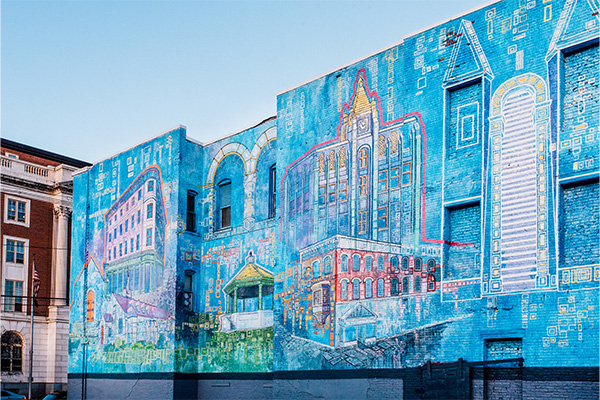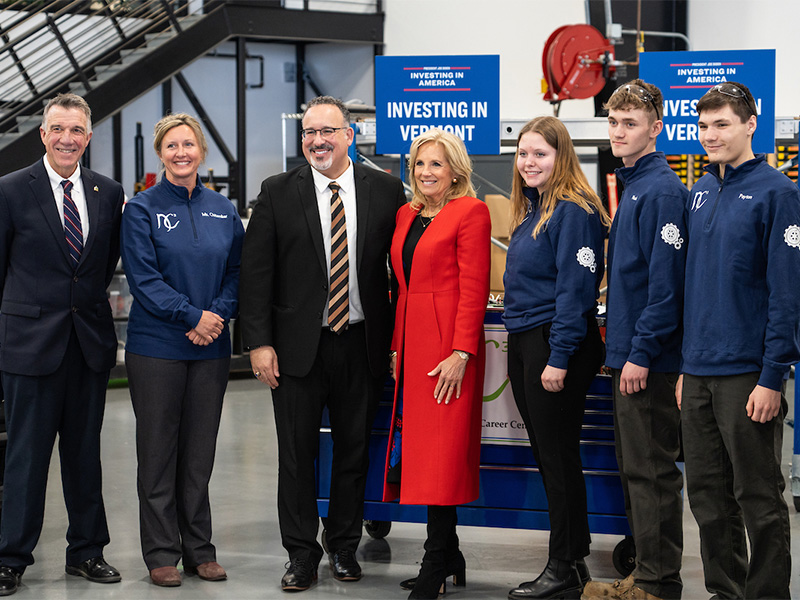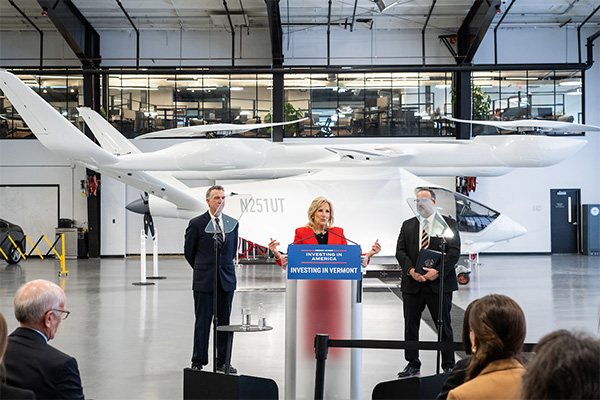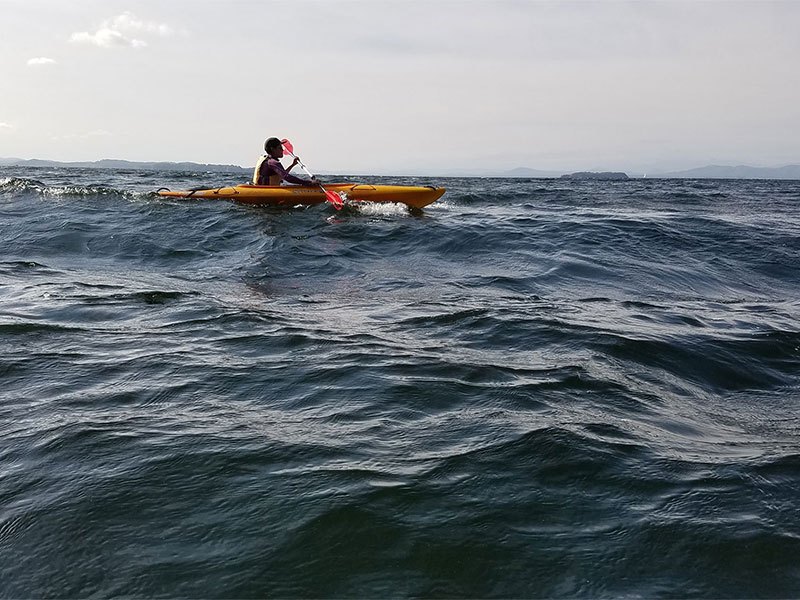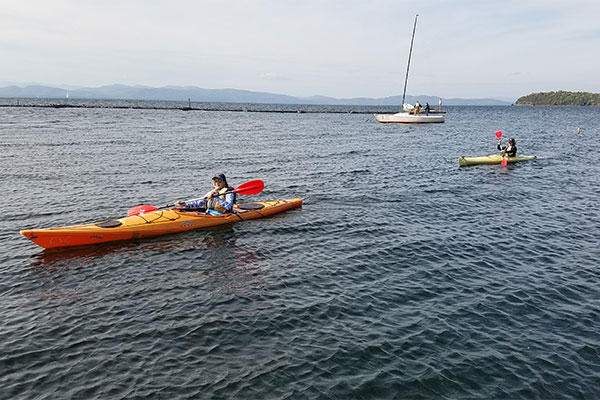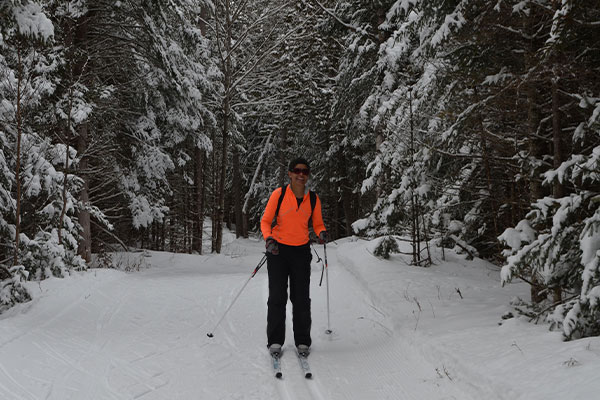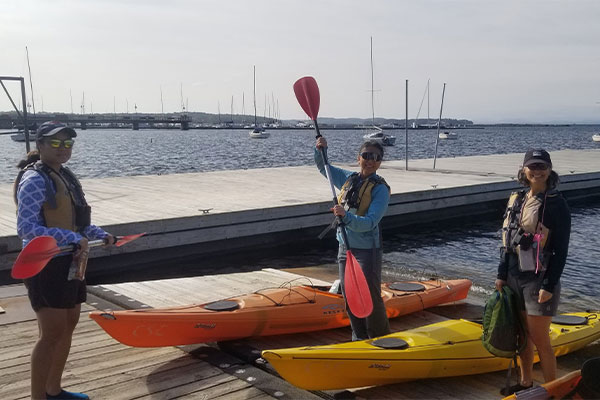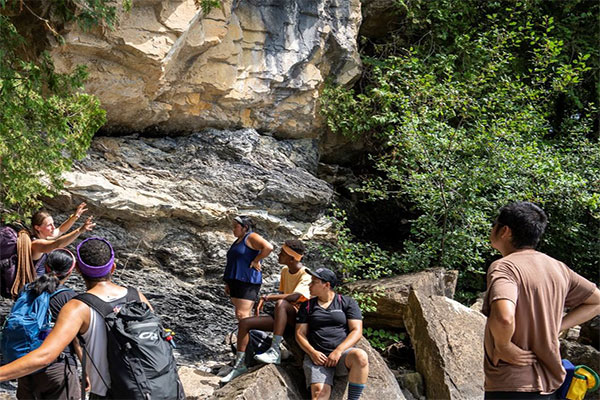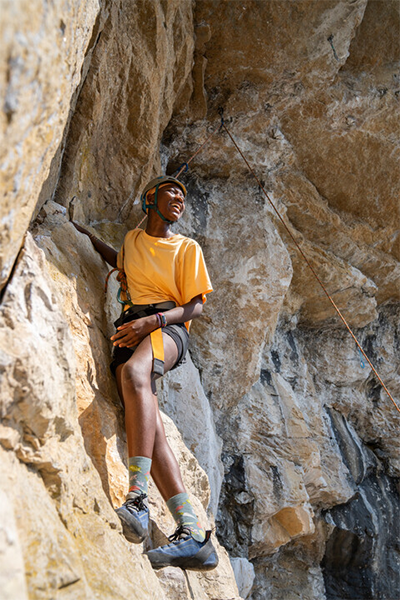
by Shelley Pembroke | May 2, 2023 | Entrepreneurship
Vermont’s accessible, small-business-driven economy is made up of innovative people with ideas. Vermont communities foster originality and bring out the best in people, providing the human, social, and financial capital that emerging businesses require to succeed. Get to know Vermont entrepreneurs through this occasional series in partnership with the Vermont Small Business Development Center.
By Amanda Kuhnert
After raising their family in North Carolina, Steve Kenny and Kirstin Behn decided to move back to Kirstin’s hometown of Waitsfield to be closer to family and enjoy Vermont’s four seasons. Steve, who has been involved in clothing retail for 30 years, envisioned opening his own store. But he first had to find a building.
“All the stars aligned,” Steve said. When a building became available on Main Street in Waitsfield, he jumped on it. The couple renovated the space to include an upstairs apartment, where they now live, and a retail space on the lower level. In October of 2022, they opened their clothing store, the Mad Rover (formerly Mad River Outfitters).
“I would call it an outdoor boutique,” Steve said. “I sell coats, jeans, blankets, underwear, but nothing technical. I don’t sell ski pants; there are eight other stores in the area selling them.”
Putting a plan into action
After writing a business plan, Steve reached out to the Vermont Small Business Development Center (VtSBDC) for help turning his idea into a viable business. His business advisor, Charley Ininger, has been advising small business owners in central Vermont for over a decade.
“Charley gave me an economic rhythm—what to expect with the seasons,” Steve said. “I lived in North Carolina for the past 17 years, where it is sunny year-round. Here, it was all about learning my peaks and troughs. I’ve learned that when the weather is sunny, people come out to shop. When there’s snow on the ground, Fridays, Saturdays, and Sundays are my busy days.”
Ininger also helped Steve learn to make more accurate financial decisions. At previous jobs, Steve had a controller to help with financial decision-making. “To do it myself, I had to sit down a lot more and finetune my finances,” he said. “The calculator was out nonstop. There were certain things I wanted to buy, but I had to wait.”
Another part of the learning curve has been figuring out what sells and what doesn’t. “People here know their labels,” Steve said. “They appreciate quality. Higher price-range items tend to sell better.” Along with investing heavily in his most popular brands, Steve has introduced a few new lines that he sold in North Carolina. He’s also bringing in more lifestyle clothing. “I went heavy on resort wear in the beginning but realize now that there is more demand for known brands,” he said.
“We’re still honing it in,” Steve said. “You live and learn. I’m five months into it. After the summer, I’ll be a wiser man.”
The Mad Rover is open 7 days a week; 10-5, Sunday through Tuesday, and 10-6, Wednesday through Saturday. Most of their products are also available for purchase on their website, themadrover.com. “People like to shop local—and order local,” Steve said.
This story was provided through a partnership with VtSBDC. Since 1992, VtSBDC has provided professional expertise and friendly guidance to thousands of business owners statewide. Whether you are an experienced business owner, a first-time entrepreneur, or a student with the spark of an idea, VtSBDC provides support through one-to-one, no fee, confidential advising as you Start. Grow. Thrive. Transition.

by Shelley Pembroke | Apr 12, 2023 | Lifestyle, Regional Spotlight, Relocation, Rutland County
Life in Rutland, Vermont is characterized by its close access to opportunity in an urban center that still feels like a small town, as well as the variety of recreational spaces amid Vermont’s natural beauty. Rutland’s community takes on projects that continuously improve the city. Investments in the city center and surrounding area makes Rutland an attractive place for families to put down roots, looking forward to a bright economic future.
With a population of about 15,800 people in 2020, Rutland is Vermont’s fifth most populous city. Killington and Pico mountains elevate Rutland’s skyline, with the city nestled in a wide valley between the Green Mountain and Taconic ranges. The Cold River and Otter Creek cut through surrounding Rutland County, Vermont’s second largest county by area. The county is also home to parts of two nationally protected natural areas, Green Mountain National Forest and White Rocks Natural Recreation Area.

Rutland was chartered in 1761 and retains the classic charm of a historic New England village with the amenities of a larger city. Rutland’s downtown is part of the National Registry of Historic Places, characterized by historic buildings like the 1913 Paramount Theatre and nods to the region’s deep history in marble quarrying, while simultaneously making space for modern energy and ventures. Healthcare workers, engineering, aerospace and manufacturing professionals, educators, and hospitality and outdoor recreation professionals all find work in Rutland, where major employers include Heritage Family Credit Union, Killington Resort, General Electric Aerospace, Green Mountain Power, Castleton University, Casella Waste Systems, and Rutland Regional Medical Center, the second-largest healthcare facility in the state. Employees at the State of Vermont also have offices in Rutland, including the Vermont Agency of Human Services and the Vermont Agency of Transportation. Remote workers bringing their jobs to Vermont can find community at brand-new, 24,000-square-foot coworking space Hub CoWorks, complete with podcasting space and room for an artist incubator as well as hot desks, private desks, and meeting rooms, or find private meeting space or room to kick-start an entrepreneurial venture at The Loft. Artists and makers looking to share space and equipment will find both at the MINT. The Rutland Young Professionals group brings people together to network and elevate their careers. Explore careers in Rutland using the Chamber and Economic Development of the Rutland Region’s Career Hub.

Rutland is well connected to the larger New England area, about two hours from Albany, N.Y., four and a half hours from New York City, three hours from both Boston and Montreal, and about two hours from Concord, N.H. Amtrak’s Ethan Allen Express provides daily service from Rutland to New York City, with a northern terminus in Burlington. Getting around in Rutland is made easier on The Bus, operated by Marble Valley Regional Transit District, which also runs tourist buses to Okemo Mountain Resort and Killington Mountain Resort. The Rutland Regional Airport operates flights to and from Boston three times daily.
Community life in Rutland is welcoming and active, with many annual events on the calendar. Outdoor recreation is always close at hand in the city and its surrounding area. Lake Bomoseen, about 20 minutes by car from Rutland, is the largest lake entirely within Vermont’s borders, and Bomoseen State Park provides hiking, swimming, and other recreation opportunities by its shores. The Chittenden Reservoir, a 721-acre natural area prized for its fishing opportunities is also about 20 minutes outside of Rutland. Killington Mountain Resort, often home to the longest ski season in the East and boasting access to Pico Mountain as well, is about 20 minutes away. Okemo Mountain Resort is about 35 minutes away from Rutland, offering two main base areas, six terrain parks and 121 trails. Pico and Okemo are well-known family and learning mountains. Killington and Okemo both offer cross-country skiing, and about 45 minutes away is Viking Nordic Center in Londonderry with 26 maintained kilometers of trails. Mountain bikers, trail runners, and hikers enjoy 16 miles of single-track spread over 325 acres at Pine Hill Park and a multitude of trails at Slate Valley Trails. Vermont’s 272-mile Long Trail intersects near Killington, and the Appalachian Trail intersects with Rutland, too. Nearby state parks include Lake Bomoseen State Park, Half Moon Pond State Park, Emerald Lake State Park, Taconic Mountains Ramble State Park, and Lake St. Catherine State Park. In late summer, families can explore Hathaway Corn Maze, ranked No. 2 for families in the U.S. by Kidventurous. Kids will love the city’s Fortress of Fun, an indoor play space featuring bounce houses and bumper cars, and the Wonderfeet Kids Museum. Take in art exhibitions and classes at the Chaffee Art Gallery, which offers two Art in the Park events annually. Join an indoor pickleball league at Vermont Sport and Fitness Center, also offering Pilates, tennis, and other community-powered sports and fitness classes, or hone your indoor rock climbing skills at Green Mountain Rock Climbing Center.
For entertainment, explore the Rutland Sculpture Trail or the city’s mural project, take in a show at the Paramount Theatre, or mark your calendar for the annual Middletown Springs Strawberry Festival. Experience the Rutland Halloween Parade, a town classic since 1960, Friday Night Live summer concert series, Rutland Winterfest, the Whoopie Pie Fest, or an annual holiday tree lighting where Santa arrives by fire truck.

Vermont residents enjoy immediate access to locally grown food, and Rutland is no exception. Meet and forge connections with local growers, artists, and producers at Vermont’s largest year-round farmers market, along with a variety of outdoor markets, the Rutland Co-op, and community-supported agriculture packages to supplement your grocery list with local, healthy essentials. Explore local food and farmstands in Rutland. Pittsford’s New England Maple Museum houses the most extensive collection of maple sugaring equipment in existence. Downtown, enjoy a meal crafted from what’s local and in season at Roots the Restaurant, Center Street Alley, or the Hop’n Moose at Rutland Beer Works, or head to nearby Killington for a meal at the Lookout Tavern or Casey’s Caboose.

In 2022, Realtor.com named Rutland one of the 14 ski towns in America where housing is more accessible, considering its access to mountains, natural snowfall, and built-in community and rich history. The publication also named Rutland among the 10 most affordable small towns readers want to live in. Housing organizations are imagining housing in new ways in Rutland, from building new developments at the site of a closed college to rehabilitating existing housing stock in West Rutland. The Housing Trust of Rutland County works to connect people with housing, both apartments and single-family homes, throughout Rutland County, and to create new developments, including net new affordable housing at Tuttle Block. The city center will also make use of new investment through the Center Street Streetscape Improvement Plan, transforming a key downtown block into a dynamic and vibrant space with enhanced pedestrian space to walk and window-shop, improved parking, safe outdoor seating for restaurants, and plants and public art. “Beginners Mind,” a mural project installing colorful outdoor murals downtown, adds character and identity to the Rutland city center. Those looking for housing can also check the Rutland Herald, the city’s daily newspaper.

Thinking about relocating to the Rutland? The Real Rutland concierge program can connect you with personal contacts for career, housing, education, and community questions. Programs both statewide and region-specific can help potential new Vermonters find information, answers to their questions, and planning resources for a move. Kick off a job search by browsing positions currently open in Vermont. Economic development tools, incentives, and special programs can also help those looking to expand or relocate their businesses to Vermont. Connect with a Vermonter to ask questions about relocating.

by Shelley Pembroke | Apr 11, 2023 | Aerospace & Aviation, Innovation
First Lady Dr. Jill Biden recently stopped in Vermont as part of the Biden Administration’s “Investing in America” tour. The visit to Vermont, which also included U.S. Secretary of Education Miguel Cardona, was to highlight the good work being done in the state to prepare students through the state’s career and technical education programs.

Recent Federal investments through the Bipartisan Infrastructure Bill and the CHIPs and Science Act mean millions of dollars are available to further this type of education and create opportunities across Vermont for students seeking a career in the trades.
The visit centered around BETA Technologies in South Burlington, a Vermont company on the cutting edge of developing and producing electric powered aircraft. The company also has an internship program dedicated to supporting students with an interest in the jobs of the future.

“What you are doing in this community is the future of our workforce, how we grow our economy from the bottom up and the middle out,” said the First Lady. “Keep innovating in how you have high schools and colleges work together so that every young person has a pathway to the jobs that are critical to rebuilding our infrastructure, propelling our clean energy future and revitalizing our manufacturing right here at home.”
Governor Phil Scott welcomed the First Lady when she landed and toured BETA Technologies with her and along with Vermont’s Congressional Delegation. Governor Scott, a Republican who benefited from technical education while a student, welcomed the Democratic first lady saying some issues are above politics. He also emphasized the importance of this moment.
“If we do this right, all the infrastructure work that’s being contemplated will move our nation forward, not only economically, but beyond the divisive partisanship that’s become the norm in our country. Dr. Biden, I don’t know you well, but I think you’d agree in my belief that everyone is born with a gift, and sometimes we just need to explore long enough to find it,” said Governor Scott. “So as we work to make the most of this historic opportunity, our job is to make these educational paths easier to find, interesting to explore, and rewarding to pursue.
Read more about the visit from local news outlets WCAX and VT Digger who both covered the event. Read Governor Scott’s full remarks including his own story of how technical education supported his early career aspirations.

by Shelley Pembroke | Apr 3, 2023 | Diversity, Lifestyle, Outdoor Recreation
By Debbie Archer
There are two things that help me stay healthy and happy in Vermont. One is to find a reason to get outside every season, in the spirit of the old rhyme Whether the Weather. Summer in Vermont makes this gloriously easy, with lush green mountain tops beckoning hikers to the summit and cold streams offering a reprieve from July’s heat. The second thing is finding other folks who are excited to revel in the joy of the outdoors with you, in whatever way you choose. Ideally, these folks will help hold you accountable to your commitment to go outside, say, when it’s cold out for that full moon snowshoe hike or when mud season has made trails impassable so you go for a bike ride on the rail trail. Some of Vermont’s seasons make it harder to get out of bed than others, but when I have made a commitment to other folks, that is often the edge I need to get in my base layers on a Saturday morning in January. And the commitment doesn’t have to be made to a group of people you know well, but could be to a group of folks who share a similar background and offer an opportunity for camaraderie, safety, and understanding. Increasingly, affinity groups are creating avenues for people of color, people with disabilities, people from the LGBTQIA+ community, and others who have been underserved and underrepresented by the outdoor industry to get outside and explore Vermont’s outdoors.

Making friends and meeting other people of color was the hardest part of living in Vermont. That is, until I started noticing outdoor affinity group meet-ups around the state. In January of 2021, a friend invited me to an Inclusive Ski Day at the Craftsbury Outdoor Center. Organizers provided an information session on what to wear and bring beforehand and then day passes, cross- country ski gear, and lessons if needed to attendees the day of. I took my ski-swap-purchased gear to the event and got helpful advice on how to improve my stride. I also had one of those funny post-pandemic moments where you meet someone in person whom you’ve only ever seen on Zoom until then. It is hard to describe how relaxed it felt to be in the company of other Black, Indigenous, and People of Color (BIPOC) skiers out in the Northeast Kingdom. It’s as if there was always a sound of static in the background and an underlying feeling of tension that was turned off and I noticed the quiet. I thoroughly enjoyed myself down to my bones.

At that first ski event, I also met Sung-Hee Chung, the founder of Powered Magazine, a lifestyle brand devoted to showing not just representation in the outdoors, but BIPOC folks finding joy in the outdoors. Powered’s mission is to magnify the full spectrum of identities that represent outdoor lovers and to promote physical, mental, and social wellbeing in communities of color through engagement in the outdoors. In the organization’s own words, “Powered Magazine strives to build equitable outdoor space for all and to expand participation in outdoor recreation.”
Since I met Sung-Hee last winter I have enjoyed outings organized by Powered Magazine in every season. She is a passionate advocate for increasing access to the outdoors for youth and people of color. She is also highly motivating and I now have a weekly ski partner all winter long. I was honored to co-host two free birding events, with binoculars provided, put on by Powered and Audubon Vermont, where I work.

After one such event where we rode bikes from Local Motion and birded along the Burlington Bike Path to Rock Point, the group of us made a plan to meet at the Lake Champlain Community Sailing Center the following weekend to kayak to the same point. Powered organized kayaks for us and we paddled out onto the water just in time for the lake to go from perfectly calm to waves and wind battering our hulls, sending water crashing into our cockpits for a thorough soaking. Staff from the sailing center were great and came out to us on a motorboat, asking if we wanted to be towed in. We each let him know we were alright to make it in of our own power, at which point I proceeded to shout sea shanties into the wind, loving every second.

Programs with Powered also helped me get back to activities that weren’t new to me but were things that I hadn’t practiced recently like lap swimming and rock climbing. Powered’s “Inclusive Water Time” program brings BIPOC swimmers and non-swimmers together in a pool, to learn to swim or to improve their confidence and skills with an instructor. Swimming is such an important pastime in Vermont; everyone should have the opportunity to take lessons and to be comfortable in or on the water. Petra Cliffs in Burlington provided a good time for a group of us to climb indoors and outdoors, something I had been wanting to do since I moved here. The organized days of climbing meant that I didn’t have to feel embarrassed about being out of practice, because the other climbers ranged in skill level as well. It was empowering to have folks cheer each other on as we reached higher and higher up the wall.
Affinity groups like Powered Magazine provide opportunities that are scaffolded to support folks to either try something new in a low-risk way or to participate with others without judgment. Programs that strive for inclusive access to the outdoors, that provide a level of safety to participants, and that lower barriers of entry to outdoor recreation will help more Vermonters and visitors to Vermont get outside any time of year.
About the series
This blog was created in partnership with Powered Magazine and the Vermont Department of Tourism and Marketing. Powered Magazine strives to build equitable outdoors for all and is dedicated to increasing access and creating opportunities to engage in the outdoors, to improve the mental, physical, and social health of Black, Indigenous, and People of Color. Debbie Archer is an outdoor educator and nature enthusiast living in central Vermont. When she was young, after a family vacation to the Green Mountain State, she decided she would live in Vermont when she was older, on a farm so she could raise cats and retired race horses. Still unsure where the childhood idea came from, her tiny homestead in town is currently home to her loving partner Ira, four cats, a dog, and a small backyard flock of chickens. No retired race horses yet.

by Shelley Pembroke | Mar 22, 2023 | Diversity, Lifestyle, Outdoor Recreation
By Jesse Anderson
When I sat down to write this blog, I pondered the question, “how do I share the enormous impact being outdoors as a black woman has had on my life?” As you may imagine, it is hard to do so, yet I embark on this storytelling journey to give you a glimpse of what such experiences mean to me.
The experience I chose to share is a nature day I experienced with Powered Magazine in Burlington, Vermont. When I got the email from Sung-Hee saying that we would be out biking, rock climbing, and hiking for the day, I immediately notified my supervisor at work that I would need the day off. The anticipation of spending the day outdoors with a small group of people within the Black, Indigenous, and People of Color (BIPOC) community encouraged me to drop everything to be a part of the experience. I was grateful to have the opportunity to be out in nature with such a warm and nurturing group of people.
Sometimes the fear of being harassed and targeted in public parks keeps people from being outdoors. Oftentimes, it’s difficult for people of color to be outdoors due to systems that were put in place in the past. There is a legitimate fear within the BIPOC community that is hard to get rid of without the tools or the environment to thrive. Speaking from personal experience, safety is a priority in dismantling the systematic fear of being outdoors for people of color. There is a tangible impact on the narrative communities form about BIPOC folks in the outdoors. Due to this, you don’t see many of us outdoors, rock climbing, biking, hiking, or more.

For example, prior to attending events offered by Powered Magazine, I didn’t see myself represented in the outdoors. Therefore, I didn’t make an effort to be outside even though I knew there were health benefits to being active outdoors. The reason why the nature day experience meant a lot to me was that I was a part of creating representation for BIPOC folks in the outdoors. I felt like I was making a difference by being myself with community in nature. Powered Magazine gives BIPOC folks the opportunity to experience the outdoors in a different way and try new things. I have been able to find new joy in different activities I have never tried before and created new narratives for myself and others by being in nature more often. When I went rock climbing, I was genuinely scared to be climbing an actual rock. I’d never rock climbed before this experience, nor did I have the tools to even try this. I was only able to do this because there was a group behind me cheering me on. I felt empowered knowing that those cheering me on saw that I had the strength to reach the top.

In my everyday life, I don’t usually get the chance to be outdoors with people who look like me. I’m often finding myself having to mold into a “white world.” From problem-solving at work to supporting my family when they need help, I often find it hard to put myself and my wellbeing first. This is why being in nature and being able to pause and reflect inwards means a lot to me. Slowing down expands my capacity to feel my emotions, see the good around me, and foster joy from within. I appreciate those within the community who go out of their way to see how we are doing. Powered Magazine events are not just about BIPOC being in the outdoors but also forming genuine, caring connections with others. It isn’t just about showing up, it is about showing up and being your authentic self. They care about your goals, your dreams, and they want to help you get there. At the event, I spoke with Sung-Hee about my goals. She took the time to create an opportunity for me to use my skills and knowledge to uplift other BIPOC folks in the community through Powered, just as she did for me.
Most of the events Powered puts together are an affinity space for BIPOC folks. Being in a space such as this is very important because it gives us a place to be in communion with each other in a safe and nurturing environment. This is a place where we can be our true authentic selves. It makes a big difference because we are in a community and feel more comfortable sharing. There is less time spent worrying about having an uncomfortable conversation with someone that might lead to harm. To just be able to turn around and know that the person beside me knows where I am coming from is very important. To share the same experience and enjoy the outdoors with each other is amazing, but it is an added bonus to know you won’t get hurt. I am able to nurture this part of me that strives for a break and just be in a space where no one is trying to get something out of me.
Community wellbeing is a key element to overall wellbeing. If you feel like you belong in your community, that is the key element to your own wellbeing! When we were out for our day of hiking, I remember having deep and meaningful conversations with my peers about what the experience meant for them. We all go into nature with different intentions. Some people enter nature with the intention of finding peace, others are there for an adventure, some seek ways to get outside of their comfort zone, and others want to break the cycle of their everyday lives. It’s important to have people by your side where you belong.

For BIPOC, it has been difficult to find a space to feel this way. In most spaces, we find ourselves changing in order to fit their spaces. That’s why the outdoors is so special to people like me. Feeling psychologically and physically safe in the outdoors is essential for sustaining a healthy relationship with nature. The outdoors has always been able to pour its energy back into people and replenish our mental wellbeing. Feeling connected and grounded is important for our community in order to continue creating more space for BIPOC folks in the outdoors. Therefore, the more stories and narratives that we share on an individual and group level, the more chances there are of ripple effects and narrative shifts that lead more people to become curious about the great outdoors.
About the series
This blog was created in partnership with Powered Magazine and the Vermont Department of Tourism and Marketing. Powered Magazine strives to build equitable outdoors for all and is dedicated to increasing access and creating opportunities to engage in the outdoors, to improve the mental, physical, and social health of Black, Indigenous, and People of Color. Jessie Anderson, a Liberian native now residing in South Burlington, Vermont, advocates for building positive outdoor relationships with community members. As a recent Saint Michael’s College graduate, she works with organizations using strength-based approaches to foster cultures of wellbeing and thriving communities. Her passion for engaging with other cultures, learning, and spending time outdoors fuels her desire to connect with and assist others. Jessie serves as a Program Facilitator for Powered Magazine, supporting the creation of equitable outdoor spaces and expanding participation in outdoor recreation for communities of color.
